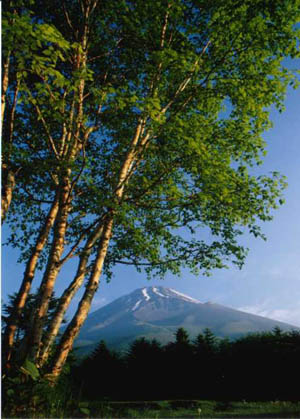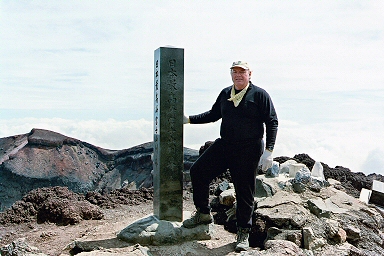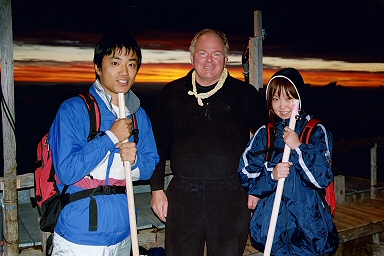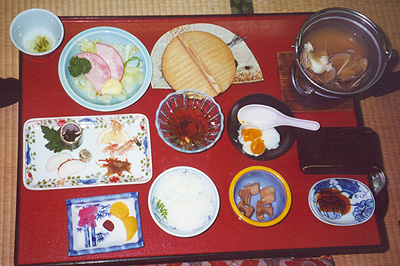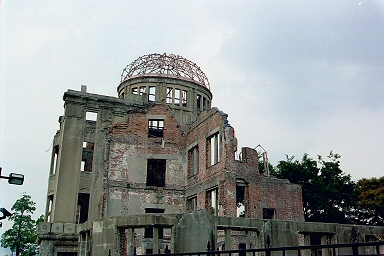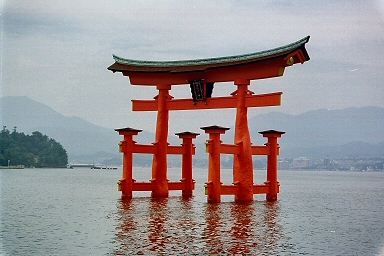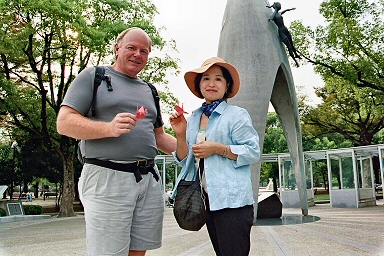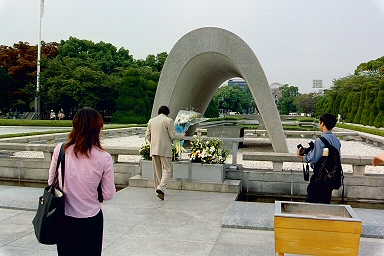I flew to Tokyo from Ulaanbaatar on Mongolian Airlines. Other than the fact that the plane was three hours late in taking off, the flight was fine. It was raining when we landed at 7:00 PM. I only had $10 USD with me so I immediately sought out an ATM at the airport to withdraw what I thought was $500 USD worth of yen, but my card was rejected, twice. Fortunately, the hotel I had planned to stay at had a free shuttle so I went to the Excel Tokyo Narita, checked-in and then emailed my bank to find out what problem existed with my card. There are a lot of airline personnel that stay at this hotel and the lobby is crowded with passengers whose planes were cancelled because of a typhoon in Taiwan. My room is nice and includes a massage chair which I enjoyed for about an hour. Tuesday, August 24th, I woke up and immediately checked for a response from my bank. In Mongolia there are about 1000 Togards for each US dollar, but in Japan, there are only about 100 yen per US dollar. I had mistakenly tried to withdraw $5000 worth of yen instead of $500 US dollars worth.
Wednesday morning I was up at 5:00 AM, packed and checked-out by 6:00 AM. I took the airport shuttle back to the airport so I could take the Narita Express to Tokyo and then to Shinjuko. Here I transferred to a bus for Kawaguchiko and then took a local bus up to the Fifth Station on Mt. Fuji, the traditional starting point for climbers. I met a couple of Americans who worked as flight crew for Northwest Airlines who were also there to climb. We had something to eat at the Fifth Station and then I left to start up for the Seventh Station where I planned to spend the night in Hindodekan Hut. The two other guys were going on to the Eight Station where they would arise at 2:00 AM tomorrow to finish climbing to the summit so see the sunrise. I felt that I would be able to see the sunrise from my hut too and did not want to hike in the dark. I reached the Seventh Station after about an hour and a half of hiking. This is a very pleasant mountain hut with sleeping places for about fifty people. There are enough huts and sleeping places on Mt. Fuji to accommodate 3000 people each night, but most of them will hike to a higher hut to be closer to the summit. Only one other couple spent the night at Hindodekan Hut and we struggled to communicate. We ate dinner together (2 meals are included when you stay at a hut) and I learned that the woman was an `office lady` and her boyfriend sold real estate. After dinner they moved over to the central hearth to smoke with the people who worked at the hut and I decided to go to bed. I slept pretty well. I had brought my sleeping bag and pad, neither of which I needed. I got up at 4:30 AM and everyone else was up also. The owner of this hut is a professional photographer and he had three huge cameras on tripods trained on where the sun would rise. I decided that I should take some shots of the sun coming up also. Breakfast was two rice balls wrapped in seaweed which I saved for further up the mountain.
In about three hours, I reached the Fifth Station where I had started and immediately rehydrated myself. I had decided that I would take the local bus back to Kawaguhiko and spend the night there before returning to Tokyo tomorrow. At a tourist information booth at the bus station I found a nice hotel on the lake, the Fuji Lake Hotel where I got a room with two meals for 21,000 yen. I showered and realized that I had no clothes to wear for dinner where I had a reservation at 6:30 PM. I quickly washed a polypro shirt & pants and hoped they would dry while I went out and soaked in the mineral springs. The hotel had provided a nice robe which I used to go down to the pool area. Being the only westerner at this Japanese Inn where, to my knowledge, not many people spoke English, I felt a little odd walking through the lobby wearing only a robe, but no one seemed to care. My clothes were still a little wet when I returned to the room so I put the hair dryer to good use for 10 minutes before getting dressed to go to dinner. Feeling presentable, I went to the dining room, where, to my surprise I found that most people were wearing the robes which the hotel provided, to dinner! I actually felt out of place in my street clothes.
Breakfast was at 7:00 AM. The buffet featured a wide array of Japanese food most of which I tried to sample. I had hoped that I would get a good view of Fujisan (as the Japanese call the mountain) from the restaurant which has huge glass windows facing the mountain, but it was enshrouded in clouds. I could make out the faint outline of the nearly perfect shape of the cone which overshadows the whole town, but it was not clear enough to photograph. I took a 10:00 AM bus back to Shinjuko where I transferred to the Airport Express to Narita. When I arrived, I discovered that there was an hour wait for the free shuttle to my hotel so I took a taxi the five miles at a cost of about $18 US dollars. I checked-in and reclaimed the bag I had left. I decided I needed a massage from a real person which was very enjoyable. I spent a lot of time on the Internet trying to find a place to stay in Tokyo so I would not have to commute three hours each day to get to town. It is quite difficult to find a reasonable hotel and I went to sleep without having confirmed any reservations for tomorrow night. Sunday morning I ate breakfast and then got back on the Internet to continue my search for accommodations. I finally found a small inexpensive hotel near the Imperial Palace where I could stay for the next few days. I checked-out of the Excel Tokyo and took the Narita Express to downtown Tokyo where I hailed a taxi to the hotel. My room is extremely small (about 8 square meters), but it cost only one-third of what I paid Thursday in Kawaguchiko. I explored the neighborhood, did some laundry, but otherwise relaxed as my legs were still very tight from hiking. There is a `super typhoon` bearing down on Japan and it looks like we may get hit pretty hard. I plan to stay in Tokyo, using the subways & trains to see what I can without getting too wet and then head down to Hiroshima on the bullet train next week. Sunday I toured the Tokyo subway system which consists of ten private lines. I found it very complicated with long walks between different lines when transferring. Some stations are many blocks long and the transfers are all made underground. I went to Shinagawa where I wanted to check out the Shinagawa Prince Hotel where I was considering moving. The hotel is directly across from the train station and is a vibrant community of shops and activity centers. I will try to move here in a couple days. I also walked over to the Central Wholesale Market which is closed on Sundays, but I plan to come here again early tomorrow morning to see the tuna auction and I wanted to get the lay of the land. I got lost and spent an hour wandering around Ginza. Finally, I got my bearings and took the subway back to The Sakura Hotel where I bought some dinner at the local supermarket and retired for the night.
After the auction I wandered through the wholesale stalls where the whole tuna are cut into pieces using giant band-saws. These stalls are where the supermarket and other wholesale buyers come to purchase what they need each day. I was disappointed that my video camera had a dead battery, but was able to take lots of photos with my still camera. At 7:00 AM I left the market and headed for Hamamatsucho Station where I planned to take a one-day tour of the major sights in Tokyo. What I thought was a fifteen minute walk took an hour and a half as I got lost again, but was able to finally get to the station in time for the 9:00 AM start.
The bus headed back to the terminal, but I decided it would be faster to return to my hotel via the subway. Without much difficulty, I made it back before 5:00 PM. It had been a hot and humid day but now it was getting windy. There were pictures on TV of all kinds of damage being caused by the typhoon in Southern Japan, but the track of the storm seemed to indicate that it would pass west of Tokyo. Tuesday morning I did some laundry and then packed for my move down to Shinagawa. Although I was certain I could get there by subway, with a backpack and large suitcase, I decided to take a cab. I had to wait a couple of hours to check-in, but there was a Yahoo Cafe so the time passed quickly. My room is much bigger and after I got settled, I went out for a walk in the neighborhood. Tokyo has a series of 28 neighborhood walks through `Ancient Tokyo`, one of which I stumbled upon so I followed it for a while. When I returned to the main road, I found a TGI Fridays so I stopped for lunch. I spent the afternoon window shopping in Shinagawa and then went back to the Internet Cafe to plan my next trip. I am hoping to go to South Korea when I leave Japan, but donít know anything about it yet. Wednesday I bought a ticket for the Bullet train which would take me to Hiroshima tomorrow at 300KM/hour. I took the subway over to Roppongi where I explored the `Westernized` section of Tokyo. I visited the recently completed Mori Tower where I watched what I later learned was an earthquake drill. Roppongi is the section of Tokyo where most foreign embassies are located and it has developed many businesses, restaurants and night clubs catering to western tastes. It was hot and humid again today so I returned to my hotel early and started reading my new book on Korea.
I returned to my hotel around 6:00 PM, bought some dinner and went to my room to eat. I turned on CNN and the report of the Russian Special Forces re-taking the school in Southern Russia where a thousand people were being held hostage had just come on the air. I ended up staying up all night watching the live reporting as that tragedy unfolded. Saturday I checked-out of my hotel in Hiroshima and took the Shrinkensen two hours north to Kyoto, the ancient capital of Japan. I had made reservations to stay at the Kyoto Tower Hotel which has a 100-meter tower on top of a 10-story hotel across from the train station. There is a huge underground mall which extends for eight city blocks under the train station which I used to walk to my hotel. After checking-in, I explored the area and bought some dinner which I took back to my hotel to eat. I arranged to take a city tour on Monday. On Sunday I followed the 'Temple Walk' as prescribed in one of my guidebooks. When Kyoto was the capital, the Emperor was worried that Buddhist Monks would gain too much power so he forbade the construction of Temples within the city walls. There are over 2000 Shrines and Temples in Kyoto, but almost all of them are outside the ancient city walls in the surrounding hills. My first stop was a couple of kilometers east of my hotel at Sanjusangendo Hall, the worlds longest wooden building, renowned for it's archery tournaments. It contains 1001 statues of Karron from the 13th century. In one famous archery tournament contestants shoot arrows down the 120 meter hallway of the main hall for 24 hours. One 18 year old holds the record for firing over 13,000 arrows, half of which hit the target. Across the street is the Kyoto Museum where I spent a couple hours looking at the important artwork from various shrines and temples which has been collected here for safekeeping. Most of the works are over 1000 years old. I continued on my 'Temple Walk' through the backstreets of Kyoto to Kiyomizu Temple, a World Heritage site. In the afternoon, being somewhat 'templed-out' I walked back to my hotel via the main shopping street in Kyoto. There was certainly ample opportunity to purchase ceramics, silks, fans and unusual foodstuffs along the way. In the underground mall I discovered a huge supermarket with an unbelievable selection of prepared foods where I bought some things and returned to my hotel for dinner. At 7:08 PM a large earthquake hit Kyoto. I ran to my window, still unsure of what was happening, where I could see the 100-meter tower on the top of my hotel shaking violently in the reflection of the glass building across the street. Although I was very frightened, there was nothing I could do. The earthquake lasted about 30 seconds, after which an announcement, in Japanese, came over the hotel's PA system. Assuming it translated into something like 'run for your life' I rushed downstairs to the lobby where everything seemed normal. The announcement had been the 'all clear' signal. I decided to walk around outside for a while before returning to my room. There were special reports on TV, again in Japanese, about the earthquake which indicated it was a 6.9 magnitude and there was a tsunami warning for the coastline. It took me a while to get to sleep, but shortly thereafter at 11:58 PM a second earthquake hit. I felt I was on a ride at an amusement park. It was hard to believe that a building could shake so much and still remain standing. This second earthquake measured 7.4 and the Tsunami warning was for a larger area of coastline. The tsunami warning was calling for a 1 meter wave, hard to imagine that it would do much damage, but I later learned that it swamped 14 boats. No people were seriously injured in the earthquakes. Monday I had scheduled a one-day tour of Kyoto. There was much talk among the westerners about the earthquakes, but the local people seemed to take them in stride. The tour started at Nijo Castle, residence of the Tokugawa Shogun. The hallways were especially constructed 'nightingale floors' which squeak when walked upon alerting residents of someone's presence to avoid sneak attacks. Then we visited Rokuon-Ji Temple, site of the Golden Pavilion, a three story building completely covered with gold leaf, both inside and out. Our final stop of the morning was The Imperial Palace. The palace was the residence of the Emperor during the period that Kyoto was the capital of Japan. The buildings are now mostly ceremonial, but the Emperor does stay here when visiting from Tokyo. We went to a souvenir shop for lunch and I decided to change my afternoon plans and visit Nara instead of going back to some of the temples I had visited yesterday on my own. Nara was the capital of Japan for less than 100 years during the 'Nara Period' which immediately preceded the establishment of the capital at Kyoto. The bus was full for the 1 1/4 hour ride to Nara. The main attraction at Nara is the Todaiji Temple, the world's largest wooden building which houses a 300 ton cast bronze Buddha. We also visited the Kasuga Shrine before returning to Kyoto at 6:00 PM. There were no earthquakes Monday night, but there is a second typhoon approaching which I will need to plan around if I am to go to Pusan by ferry after visiting Osaka. Tuesday I had not planned to do anything. I watched coverage on TV of the typhoon, which, although it did not affect Kyoto, scored a direct hit on Hiroshima. Most of the buildings at the shrine at Miyajima which I had visited the other day were severely damaged. A number of trees in Peace Park, a couple of which had withstood the atomic bomb blast in 1945, also were toppled. Pictures of huge ocean-going tankers washed up on the beach or capsized and sinking were numerous. I made reservations at a hotel in Osaka for the next couple of nights and will take the train there tomorrow after I go on a popular walking tour of Kyoto which takes place in the morning. Wednesday morning I packed-up and checked-out of The Kyoto Tower Hotel and left my luggage with the bellman while I went on my final tour of the city. A local character named Johnnie Highwalker, who I guessed to be about 70, has been leading a 5-hour tour of the back-streets of Kyoto for nine years. We started out at The Higashi Honganji, the national center of Japanese Buddhism. This temple has burned down and been rebuilt four times, most recently in 1895. As there was little money at the time, tens of thousands of volunteers from all over Japan flocked to Osaka to reconstruct the temple. Huge elm trees were felled in the surrounding forests and hauled to Osaka on large snow sleds. The ropes used for the hauling of these sleds is about 4 inches thick and often over 100 feet long. The rope is made from human hair donated by the workers and is on display at the temple. The temple is currently undergoing a refurbishing and has a large metal superstructure over its roof. From here we walked through the back-streets of Osaka where we stopped frequently at various shops where people were manufacturing local products. We observed the making of fans, prayer beads, tofu, tsami mats, furniture and sliding paper window screens. Often the shop owners were 6th or 7th generation members of the same family which had owned the business. We walked through the Geisha district, visited some more temples and then headed to the east side of town to visit some shopping streets. I had already seen this last section so I decided to leave the tour a little early and take the train to Osaka. I took the Shinkensen to Osaka-Shin which I learned was not Osaka, but the Shinkensen station closest to Osaka. I had to transfer to another train to get to the area where I was staying. I checked into the Dai-Ichi Hotel and then went to a local Kinkos to use the Internet. I walked back to the train station to have dinner at the 8 acre underground mall which contains hundreds of shops. Thursday I ate breakfast and then headed back to Kinkos to finish up on the Internet. I took a subway out to Osaka Castle, a beautifully reconstructed castle originally built by Hideyoshi Toyotomi, a one-time unifier of Japan who later lost the castle in a battle and committed suicide. I returned to my hotel for lunch, but went out again in the afternoon to the waterfront to check out the ferry service to Korea. It took an hour to get to the International Ferry Terminal and I got there just in time to see my ship leaving for the 18-hour trip to Pusan, South Korea. The ship will come back tomorrow and I will take it on Saturday. Friday, September 10th after breakfast I went to Kinkoís to make my reservations for Korea. I was a little hesitant about traveling on 9/11, but decided to go anyway. I then headed to Namba where I spent several hours exploring this very traditional section of Osaka. I think it would be possible to visit every major city in Japan and explore all of their respective neighborhoods, without ever going outside. Not once today did I ever leave the subterranean maze of subways, shops and corridors that connect all major hotels and buildings. Even when I visited Doguyasuji, the market street devoted to kitchen and restaurant supplies, I found the entire street had been enclosed, creating a weatherproof environment. Not until I returned to my hotel and looked out the window did I discover that it had been raining. After making one last trip to Kinkoís on Saturday morning I checked-out of my hotel. After consulting with his co-workers, my taxi driver assured me he knew how to get to the International Ferry Terminal and then promptly took me to the domestic terminal. Since I had scoped out this area a couple days ago, I was able to show him where to go, much to his embarrassment. After much apologizing and a reduction in the fare, both of which I accepted, we arrived at the correct terminal. The International Ferry Terminal looks like a container port. During my last couple of hours in Japan, I watched trucks loading the lower section of my ferry with containers for transport to Korea. |

